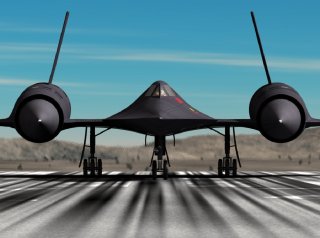The Crazy Story of How Russia 'Helped' Build the SR-71 Blackbird
If the Soviet Union had known that its exports were being used to build American planes, then it certainly would not have sold them.
Perhaps no plane—other than the U-2 Dragon Lady—is as reminiscent of the Cold War as the SR-71 Blackbird. The airplane is instantly recognizable at a distance, distinguishable for its long, curved nose and twin jet engines. In many ways, it is a symbol of the power of the U.S. Air Force, the ingenuity of U.S. aircraft manufacturers, and the talent of the “Skunk Works” team at the Lockheed Corporation that constructed it.
As strange as it seems, however, the United States cannot claim sole credit for the development of the Blackbird. A crucial partner in the plane’s development, albeit an unwitting one, was the Soviet Union.
“Skunk Works” at Work
The Lockheed A-12 reconnaissance aircraft, which became the basis for the sleek SR-71 Blackbird, had a unique aerodynamic design that helped it to routinely fly at speeds exceeding two thousand miles per hour. While other, more conventional planes could approximate this speed, they could only do so in short bursts, using their afterburners—and using up crucial fuel in the process. This incredible speed meant that the plane did not need to evade or deploy countermeasures against anti-air missiles; it could simply outfly them.
The A-12 ai craft’s speed, however, came with a major drawback: friction, and therefore heat. Aluminum, which most planes were constructed from, simply could not handle the temperatures created by a Mach 3 cruising speed. Stainless steel could, but it was far too heavy to build a supersonic plane from.
This led the aircraft designers at Skunk Works to begin experiments with titanium, which combined a lightweight with high tensile strength and durability at high temperatures. After considerable trial and error, Skunk Works had a workable design for an aircraft, composed of more than 90 percent titanium.
The CIA Steps In
The more significant problem, however, was that the United States simply did not have sufficient reserves of domestic titanium ore to construct planes from. The Soviet Union, however, did and had made it available for export.
Of course, if the Soviet Union had known that its exports were being used to build American planes, then it certainly would not have sold them. And even if the United States had not declared the purpose of its imports, bureaucrats in Moscow would likely have raised their eyebrows at the quantities of titanium that the U.S. government was suddenly interested in. This led the Central Intelligence Agency to begin a program of clandestinely buying the ore, using dummy corporations and third world countries as intermediaries.
Ultimately, the CIA was able to secure enough titanium to construct 32 SR-71s, along with more than a dozen A-12s and a handful of derivative planes—all from minerals illicitly obtained from the Soviet Union. Spasibo, tovarishchi!
Trevor Filseth is a writer for the National Interest.
Image: Reuters

